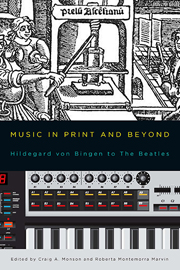Book contents
- Frontmatter
- Dedication
- Contents
- Acknowledgments
- Introduction
- 1 Robert Granjon and Music during the Golden Age of Typography
- 2 Publishing Music Theory in Early Cinquecento Venice and Bologna: Friends and Foes
- 3 Preaching to the Choir: Arts of Persuasion in the Converts of Italy
- 4 Music Distribution in London during Handel's Lifetime: Manuscript Copies versus Prints
- 5 Beethoven's Miniatures
- 6 “The Beautiful and the Ugly”: Travel Literature, Racial Theory, and a Schumann Song
- 7 Verdi's “Music of the Future”
- 8 The Suspended Voice of Amália Rodrigues
- 9 More than Mostly Mozart: Teddy Wilson's “China Boy”
- 10 Wanted Dead and Alive: Historical Performance Practice and Electro-Acoustic Music from IRCAM to Abbey Road
- 11 Lowinsky's Secrets
- 12 The Unknown Hildegard: Editing, Performance, and Reception (An Ordo Virtutum in Five Acts)
- List of Contributors
- Index
12 - The Unknown Hildegard: Editing, Performance, and Reception (An Ordo Virtutum in Five Acts)
Published online by Cambridge University Press: 05 March 2014
- Frontmatter
- Dedication
- Contents
- Acknowledgments
- Introduction
- 1 Robert Granjon and Music during the Golden Age of Typography
- 2 Publishing Music Theory in Early Cinquecento Venice and Bologna: Friends and Foes
- 3 Preaching to the Choir: Arts of Persuasion in the Converts of Italy
- 4 Music Distribution in London during Handel's Lifetime: Manuscript Copies versus Prints
- 5 Beethoven's Miniatures
- 6 “The Beautiful and the Ugly”: Travel Literature, Racial Theory, and a Schumann Song
- 7 Verdi's “Music of the Future”
- 8 The Suspended Voice of Amália Rodrigues
- 9 More than Mostly Mozart: Teddy Wilson's “China Boy”
- 10 Wanted Dead and Alive: Historical Performance Practice and Electro-Acoustic Music from IRCAM to Abbey Road
- 11 Lowinsky's Secrets
- 12 The Unknown Hildegard: Editing, Performance, and Reception (An Ordo Virtutum in Five Acts)
- List of Contributors
- Index
Summary
The first note is wrong—the very first pitch of the first modern edition of Hildegard's music is, quite simply, the wrong note.
The symbolism is too powerful to ignore. The literal start of the publication of her music, the commencement of the rebirth of her song, is incorrect. This misstep, as it turns out, was prophetic. As the following essay will show, the publication of Hildegard's music has, for almost 150 years, usually misrepresented her in one way or another. It is thus all too fitting that the direction was off from the very start.
Hildegard's music is now well known in both academic and early music circles and has made a considerable impact on the general listener as well. Multiple recordings exist of her play with music, Ordo virtutum (the Play of the Virtues), as well as of almost all of her seventy-seven chants. We have facsimile editions of both of the main sources of her music, the Dendermonde Codex and the Riesencodex (two facsimiles of the latter, in fact, one dating back to the early twentieth century). Transcriptions of selected works go back still further, to the nineteenth century, and we have two extended editions of her music, one in standard notation and another in modern chant notation.
This staggering amount of material stands in stark contrast to the works of most medieval composers, as well as to the output of many important women composers of later eras.
- Type
- Chapter
- Information
- Music in Print and BeyondHildegard von Bingen to The Beatles, pp. 258 - 306Publisher: Boydell & BrewerPrint publication year: 2013

